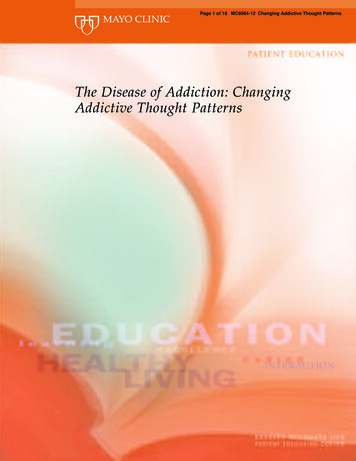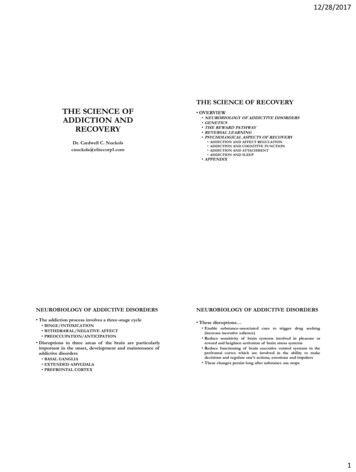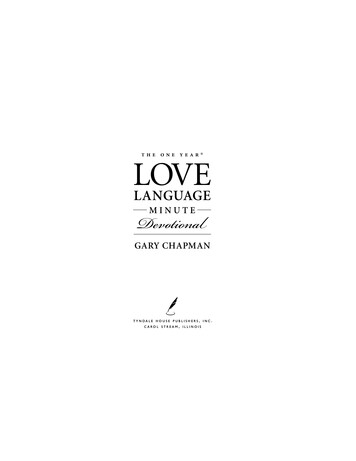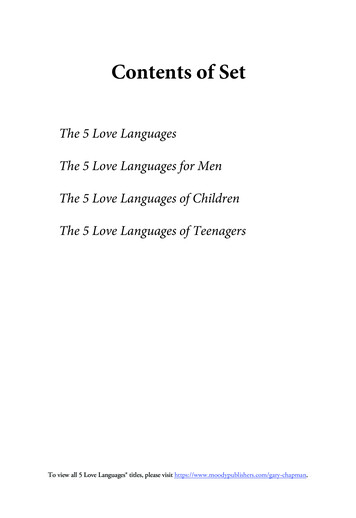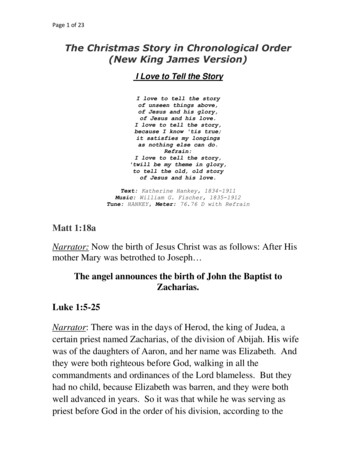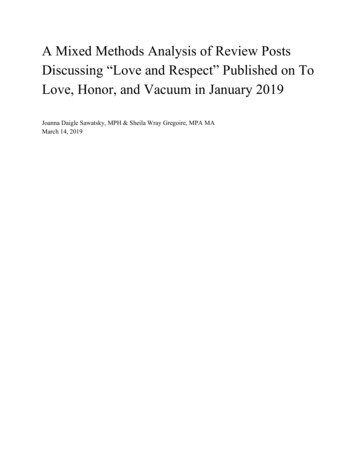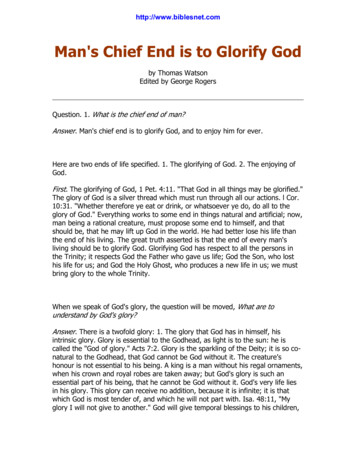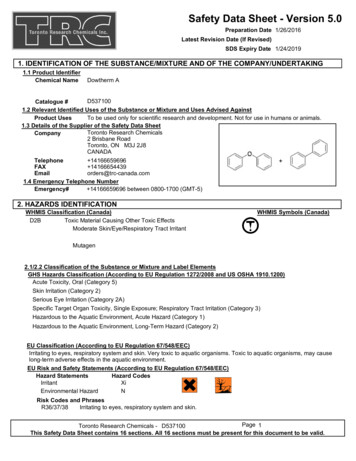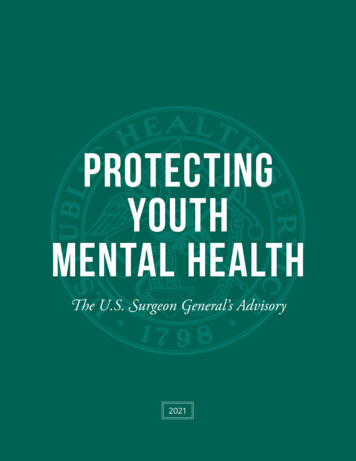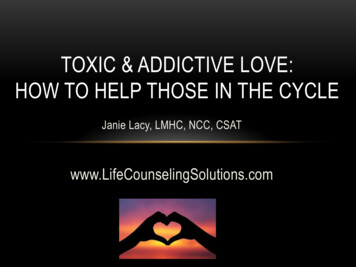
Transcription
TOXIC & ADDICTIVE LOVE:HOW TO HELP THOSE IN THE CYCLEJanie Lacy, LMHC, NCC, CSATwww.LifeCounselingSolutions.com
TODAY’S OBJECTIVE Cultural influences Attachment styles Love on the brain Cycle of toxic love Interventions to break the cycle Q&A
TOXIC LOVE: HEADLINE NEWS
LET’S TALK ABOUT ITCelebrities Talking About It: Interview Clip
SAFE WITH ME BY SAM SMITHIf you ever need meJust tell me and I'll be thereCause I was built for youYes I was built to carry all your feelingsCause I won't let them knowI won't let you go babyI don't care what your past isI don't need no answersJust have faith in me
REHAB BY RIHANNABaby, babyWhen we first metI never felt somethingso strongYou were like my loverAnd my best friendAll wrapped into oneWith a ribbon on itAnd all of a suddenyou went and leftI didn't know how to followIt's like a shockThat spun me aroundAnd now my heart's deadI feel so empty and hollow
"As long as we believe that someone else has thepower to make us happy then we are setting ourselvesup to be victims”Codependence: The Dance of Wounded Souls
WHAT IS
WHAT IS LOVE ADDICTION?Individuals do not fall in love with someone who will return theiraffection. Rather, they are attracted to somebody who will neglectthe relationship. – Pia Mellody (author of Facing Love Addiction)Patrick Carnes (2001) – Four Primary Criteria (Addiction)1. Obsession - love object becomes the organizing principle of life. Intense,abnormal, preoccupying focus on someone.2. Compulsion – continuing behavior she/he has repeatedly attempted to stop.3. Negative consequences – persisting in a behavior in the face of detrimentalconsequences. She/he does not learn from their problematic behavior.4. Tolerance – neurochemistry (pleasure center of the brain – associated withacting out).
HEALTHY LOVE VS. TOXIC LOVEHealthy LoveToxic Love Conversation – to understand,help, convey affection Conversation - intent to blame,defend, or manipulate Ability to enjoy solitude by beingalone Unable to endure separation,clinging Sex is free choice growing out ofcaring & friendship Pressure around sex due to fear,insecurity & need for immediategratification Self-care by both partners,emotional state not dependenton other’s mood Loving detachment (healthyconcern about partner, whileletting go) Expectation that one partner willfix and rescue the other Fusion (being obsessed witheach other’s problems andfeelings)
CHARACTERISTICS OF THE LOVE ADDICT1)Assign a disproportionate amount of time, attention, &“value above themselves” to the person to whom they areaddicted, & this focus often has an obsessive quality.2) Have unrealistic expectations for unconditional positiveregard from the other person in the relationship.3) Neglect to care for or value themselves in the relationship.Mellody, P. (2003). Facing Love Addiction. New York: Harper Collins.
TWO FEARS: CONSCIOUS & UNCONSCIOUS Most conscious fear - fear of being left. Will toleratealmost anything to avoid being left, the fear can come fromchildhood experiences. Avoid being left & want to be connected to someone in asecure way, but the demanding connection isENMESHMENT rather than healthy intimacy.Mellody, P. (2003). Facing Love Addiction. New York: Harper Collins.
TWO FEARS: CONSCIOUS & UNCONSCIOUS Unconsciously fear healthy intimacy. Consciously fear Abandonment. Love Addicts potentially did not experience enough intimacy from theirabandoning caregivers to know how to be intimate in a healthy way.Mellody, P. (2003). Facing Love Addiction. New York: Harper Collins.
TWO FEARS: CONSCIOUS & UNCONSCIOUS Frightened by offers of healthy intimacy because they don’t know what to do.When they reach a certain level of closeness, they often panic & dosomething to create distance between themselves & their partners again.Distancing StrategiesSELF-DEFEATING DILEMMA (Double Bind) Consciously Want Intimacy But Can’t Tolerate HealthyCloseness, So They Must Unconsciously Choose A PartnerWho Cannot Be Intimate In A Healthy Way.Mellody, P. (2003). Facing Love Addiction. New York: Harper Collins.
CHARACTERISTICS OF THE LOVE ADDICT Inaccurate beliefs about who their partners is, they feel angry because oftheir repeated disappointment in the partner for not behaving according totheir expectation. Love addicts begin to retaliate with toxic fightingagainst what they interpret as willful failure to love them. Usually have serious doubts about their self-worth so they are driven toseek an experience of unconditional positive regard to heal their woundedself-esteem. Usually drawn to Love Avoidants, who try to avoid commitment & healthyintimacy & can focused on addictions such as alcoholism, work, or sex.Mellody, P. (2003). Facing Love Addiction. New York: Harper Collins.
PROGRESSION STAGES OF LOVE ADDICTION1. Increased tolerance of Inappropriate Behavior from Others2. Greater Dependence on the Person1. Decrease in Self-Care1. Numbness to Feelings – Experience waves of pain, anger, fear,shame & jealousy (report numbness).1. Feeling Trapped - Overpowering sense of being helpless to fixthe relationship or wants to escape the pain by ending it.Mellody, P. (2003). Facing Love Addiction. New York: Harper Collins.
FINAL STAGE OF LOVE ADDICTION Being abused by their partners & being abusive to their partners Inability to see the partner is there for them & times when partner’sbehavior is connecting rather than distancing (all bad). Sees almost everything the other person does in a negativelight. Focus on feeling inadequate that they miss the compliment.Demand to be loved in spite of the impact of immature, irrational,offensive behavior toward the love avoidant.Mellody, P. (2003). Facing Love Addiction. New York: Harper Collins.
CHARACTERISTICS OF THE LOVE AVOIDANTPrimary characteristics of the model partner for a love addict isAVOIDANCE, which seems unbelievable since love avoidants come on sostrongly at first.1. Evade intensity within the relationship by creating intensity in activitiesoutside the relationships (can be addictions).1. Avoid being known in the relationship in order to protect themselves fromengulfment & control by the other person.1. Avoid intimate contact with their partners, using a variety of processes suchas “distancing techniques”.Mellody, P. (2003). Facing Love Addiction. New York: Harper Collins.
CHARACTERISTICS OF THE LOVE AVOIDANT They conduct life from behind protective emotionalwalls, & they continually try to control the choices ofother people with whom they are seeking relationship. Consciously fear intimacy because they believe thatthey will be drained, engulfed, & controlled by it.Mellody, P. (2003). Facing Love Addiction. New York: Harper Collins.
LOVE AVOIDANT CYCLE1. Enter relationship because he willfeel guilty if he says no.4. Uses his resentment or sense ofbeing a victim of the relationship tomove to a wall of distance.1. Attempts to be relational behind awall of seduction to avoid feelingvulnerable & to make the partnerfeel loved or special.5. Seeks intensity outside therelationship in order to feel alive &have a life of his own.1. Feeling engulfed anyway, the LoveAvoidant moves to a wall ofresentment (anger) and gets criticalof the partner.6. Repeats the cycle by returning to therelationship out of the fear of beingleft or guilt, or by finding a newpartner.Mellody, P. (2003). Facing Love Addiction. New York: Harper Collins.
LOVE ADDICT & LOVE AVOIDANT Relationship marked by cycles of positive & negative intensity(which they call love, passion, or romance), until they can’tstand it with that partner & then they leave that person to repeatthe cycles with somebody else. Each partner is both attracted and repelled by each other.Mellody, P. (2003). Facing Love Addiction. New York: Harper Collins.
LOVE ADDICTION:PHASE ONE: ATTRACTION PHASE Instant attraction to romanticinterest, usually occurring within thefirst few minutes of meeting. An immediate urge to rush into arelationship - regardless ofcompatibility. Unrealistic fantasies about arelationship with a love interest,assigning "magical" qualities to anobject of affection. The beginnings of obsessive,controlling behaviors begin tomanifest.Becoming "hooked on the look" ofanother, focusing on the person'sphysical characteristics whileignoring personality differences.Mellody, P. (2003). Facing Love Addiction. New York: Harper Collins.
PHASE TWO: THE ANXIOUS PHASE Unfounded thoughts of infidelity onthe part of a partner & demandingaccountability for normal dailyactivities.An overwhelming fear ofabandonment, including baselessthoughts of a partner walking out onthe relationship in favor of anotherperson. The need to constantly be in contactwith a love interest via phone, emailor in person. Strong feelings of mistrust begin toemerge, causing depression,resentment and relational tension. The continuation & escalation ofobsessive, controlling behaviors.Mellody, P. (2003). Facing Love Addiction. New York: Harper Collins.
PHASE THREE: THE OBSESSIVE PHASE “Tunnel vision,” relationallydependent person cannot stopthinking about a love interest &required his or her constantattention. "Drive-bys" around a love interest'shome or work, assuring that is where"he or she is supposed to be." Monitoring activities, followingwhereabouts through the day todiscover daily activities. Extreme control tactics: questioningcommitment to the relationship (guilttrips) with the goal of manipulatingto get more attention.Neurotic, compulsive behaviors,including rapid telephone calls tolove interest's place of residence orworkplace.Unfounded accusations of "cheating"due to extreme anxiety.Mellody, P. (2003). Facing Love Addiction. New York: HarperCollins.
PHASE FOUR: THE DESTRUCTIVE PHASE Overwhelming feelings ofdepression (feeling "empty"inside). Anger, rage & a desire to seekrevenge against a love interestfor breaking off the relationship. Loss of self-esteem, due tothe collapse of therelationship. Denial that the relationship hasended & attempting to "win aloved one back" by makingpromises to "change". Extreme feelings of selfblame and at times, selfhatred. Use of drugs, alcohol, food orsex to "medicate" the emotionalpain.Mellody, P. (2003). Facing Love Addiction. New York: Harper Collins.
THE DESTRUCTIVE PHASE: WITHDRAWAL Movie Clip – Shame (22:14)
THE DESTRUCTIVE PHASE: WITHDRAWAL
COUNSELING CHALLENGE IN TREATMENT Untreated codependence, neither partner is mature enough Self-esteem problems Difficulty setting boundaries make it very difficult for eachpartner to cope with negative feedback or doing insight workwith a counselor in the presence of the partner.
THE PHASES OF RECOVERY1) Address any apparent addictive processes outside of the co-addictedrelationship (alcoholism, eating disorders, shopping, gambling, etc).1) Disengage from the addictive part of the relationship.1) Deal and release old stored up feelings from childhood abuseexperiences such as abandonment and engulfment. their internal residue of unresolved & harmful feelings from childhood.1) Underlying symptoms of codependency.Mellody, P. (2003). Facing Love Addiction. New York: Harper Collins.
PUTTING THE RELATIONSHIP ON HOLDRelationship is so toxic that the partner can’t saythings like “when you do so and so, I feel angry”without a lot of explosion or chaos. Detachment within the bonds of the relationship. Separate codependence recovery, that partners can thenwork on issues together. Partners eliminate any contact that leads to fighting intensity, &painful feelings, or trying to deal with issues of the co-addictedrelationship with each other.Mellody, P. (2003). Facing Love Addiction. New York: Harper Collins.
DETACHMENT from the addictive parts of the relationshipmeans not trying to do any kind of intense relatingwith your partner. Treat each other in a verypleasant way & go on about your own business.
DETACHMENT “RULES”1) Practice “the three gets” from Al-Anon: Get off your partner’s back, get out ofyour partner’s way and get on with your life.1) Do not bomb your partner with anger or seduction.1) Notice what is happening to your partner so you can see who your partner is.1) Notice what is going on with you.1) Do not respond to any bombs of anger or seduction from your partner (avoidmanipulative, seductive, controlling sex or fighting and anger).Mellody, P. (2003). Facing Love Addiction. New York: Harper Collins.
WOMEN REDEEMED THERAPY GROUP 30 Minutes: share experience with the previous week'sassignments. 30 Minutes: Psycho-educational: includes:understanding destructive relationships, addictions, theprocess of recovery, social & interpersonal issues,healthy support systems, managing feelings, relapseprevention, long term maintenance. 45 - 60 Minutes: Group Experiential Exercise
THERAPY GROUP RESOURCESGroup Participate Recovery Workbook bySusan Peabody The Gifts of Imperfectionby Brene Brown Ready to Heal By KellyMcDanielClinician/Leader Resource Facing Love Addictionby Pia Mellody Making Advances – acomprehensive guidefor treating female sexand love addicts
AM I A LOVE ADDICT? ASSESSMENT1.Have you ever tried to control how much sex to have or how often you wouldsee someone?2. Do you find yourself unable to stop seeing a specific person even though youknow that seeing this person is destructive to you?3. Do you feel that you don’t want anyone to know about your sexual or romanticactivities? Do you feel you need to hide these activities from others – friends,family, co-workers, counselors, etc.?4. Do you get “high” from sex and/or romance? Do you crash?5. Have you had sex at inappropriate times, in inappropriate places, and/or withinappropriate people?
AM I A LOVE AVOIDANT? ASSESSMENT You think taking care of yourpartner is sufficient proof that youlove him or her. You find yourself often critical ofyour partner. You believe it is your duty to takecare of your partner. You have a secret life away fromyour partner. You keep important informationabout your thoughts or feelingsfrom your partner. You withhold information aboutyourself (at work or play) so thatyour partner will not get upset. You find yourself needing tomanage and be in control of therelationship.
WOMEN REDEEMED: HEALING: TOXIC LOVEConceptsResources & Tools Trauma Repair Relational Timeline Building Self-Esteem Survival behaviors Learning To Love Yourself Unrealistic Expectation – NeedFor Positive Regard Self-Care Being An Adult Attachment Style Trauma wounds – trauma egg Magical Thinking Art therapy – feelingidentification Legacy Chart
SESSION ONE:WHAT IS THE STORY OF YOUR INNER WORLD?
SESSION THREE:PLEASE HEAR WHAT I’M NOT SAYINGPoem by Charles C. FinnDescribes many of our struggles withour false self
Session Three:Mask Making Purpose:To Explore One’sPersona Instructions:Consider portraying"how others seeyou" on the outsideof the mask and"how you really feelinside" on thereverse side of themask.
What Do Others See And What Do You See?
SESSION 5 0R 6: DRAMA TRIANGLE
EMPOWERMENT DYNAMIC
SESSION FIVE – EIGHT : TRAUMA EGG
SESSION 8-9: EMPTY CHAIR EXERCISE
SESSION 9: EXPERIENTIAL EXERCISEInner Child Work Begins Show and TellWhat Items Did You Bring?What did it represent for you?What do you see now?What part of you got froze? traumamessage
SESSION TEN:EXPERIENTIAL EXERCISE
LETTER TO YOUR INNER CHILD
SESSION 12: CELEBRATE! Have fun together!Ladies Night Out Females learning how tobond with other females.
"We weren't ourselves when we fell in love,and when we became ourselves - surprise!We were poison. We complete each other inthe nastiest, ugliest possible way."― Gillian Flynn, Gone Girl
WHAT DOES IT LOOK LIKE?Hot passion & mutualadmiration to seethingresentment & revengeobsession that occursbetween Nick and Amy.
It was fueled by her fantasy of his perfect love & by hisseduction, both defenses against feeling vulnerable Amy's profoundly raw pain and her rageful, obsessiveplotting is consistent with the withdrawal phase of LoveAddiction. Many love addicts not only obsess about theirpartner, but, like Amy, also compulsively act out revengefantasies. Nick's intense resentment of Amy & his victim thinking areclassic Love Avoidant characteristics used to justify treating hiswife without respect and to act out on the side.
AMY’S UNTREATED LOVE ADDICTION Swept off her feet with Nick'sseductive pursuit of her in their earlydays. She idealized him to preserve thefantasy of him being the perfect man. Relationship matured & the distancebetween them grew, she denied herreality that she was not getting enoughof him to sustain feeling connected. Her denial shattered when she sawhim kiss another woman & thus beganher vindictive plot to destroy him.
NICK IS A CLASSIC LOVE AVOIDANT Comes on hot & heavy,presenting as exciting & PrinceCharming. Amy becomes his drug (morespecifically, the pursuit of her &her intense idealization of him),until he knows he has her. Then his fear of intimacy resultsin his charms wearing off, hiswalls going up & then seekingfresh intensity in the form of anaffair.
GONE GIRL: TOXIC & ADDICTIVE LOVE Even after proving that they are poison to each other,they still decide to stay together. Love Addicts & Avoidants have a notoriously hard timeseparating because re-engaging their relationshipbrings so much intensity. Together, they are a perfectly dysfunctional match.
TOXIC & ADDICTIVE LOVE:HOW TO HELP THOSE IN THE CYCLEThank You For Your Participation!Janie Lacy, LMHC, NCC, CSATwww.LifeCounselingSolutions.com407-622-1770
outside the relationships (can be addictions). 1. Avoid being known in the relationship in order to protect themselves from engulfment & control by the other person. 1. Avoid intimate contact with their partners, using a variety of processes such as “distancing techniques”. Mellody, P.
